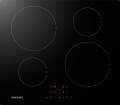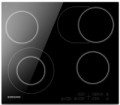Number of Hi-Light burners
The number of
Hi-Light burners in the design of the hob.
Hi-Light is an electric heater designed to eliminate the main disadvantages of solid plate burners (see above). Instead of a heating element, the “hi-lights” use a thin metal tape, and instead of a metal disc, glass-ceramic is used (see “Hob material”). Due to this, heaters of this type heat up and cool down noticeably faster than classic solid plate burners (although they are much more expensive).
Number of induction burners
The number of induction burners in the design of the hob.
A feature of such a burner is that it does not heat up by itself but transfers energy to the dishes using electromagnetic radiation. This radiation is safe for humans, and at the bottom of the dishes, it creates currents, providing heating. This format of operation provides several advantages over traditional heaters. Firstly, the burner instantly responds to a change in the operating mode — in this respect, induction heaters are similar to gas ones. Secondly, the surface of the hob (usually glass or glass-ceramic) practically does not heat up — except that part of the heat is transferred from the heated dishes; this has a positive effect on safety. Thirdly, induction burners are quite economical in terms of energy consumption. Among the disadvantages of induction heating, in addition to the high cost, we can mention that it only works with dishes made of thick steel or cast iron. Other metals on such a burner will heat up weakly, and glass, ceramics and other non-magnetic materials will not heat up at all. However, a lot of modern cookware is created specifically for compatibility with induction, which often has a corresponding designation on the bottom.
Dual-circuit burner
The presence on the hob of one or more
dual-circuit burners — heaters with the possibility of increasing the diameter.
Only Hi-Light or induction hotplates can be dual-circuit burners (see "burner type"). Such a heater looks like several circles of different diameters with a common centre; each circle corresponds to one of the options of the working diameter that can be selected for the burner. The number of these options is usually 2 or 3, and if there is more than one dual-circuit burner, they may differ in the number of diameters available.
Anyway, this feature allows you to select the working size of the burner for the diameter of the dishes. This function should not be confused with the oval dual zone (see below): the oval dual zone gives the burner an elongated shape, and the dual-circuit burner remains round regardless of the selected size.
Oval dual zone
The presence of an
oval-shaped heating zone on the hob. Such a heater is useful for working with appropriate elongated dishes (for example, goose roasters). In models with electric heaters (see "Burner type") the desired shape is provided by an additional segment installed close to the burner; the burner in normal mode works like a regular round one, and when the segment is connected, it turns into an oval. In gas models, a separate elongated burner is installed.
A similar effect can be achieved using the bridge mode (see "Features"). However, the bridge and the oval zone are still different functions: the first involves combining two burners, and the second is implemented strictly on one burner.
Number of power levels
The number of temperature settings of the burner. The more power levels, the more accurately you can set the required temperature for cooking a particular dish. However, in most cases, nine levels are enough for home use. But, if you are a gourmet and often cook unusual dishes that require strict adherence to the recipe, then you simply need more temperature settings.
Power limit
A safety feature that prevents possible problems with old wiring that is not designed for the power consumption of the hob.
The power limit protects the electrical network from a short circuit or burnout of the wiring, and the function will also be useful when working simultaneously with the other household appliances.
Dimensions (WxD)
General dimensions of the device in width and depth. Depth, in this case, refers to the distance from the leading edge to the trailing edge (when viewed from the user's side). Note that the external dimensions of the hobs are often larger than the dimensions for embedding (see below).

